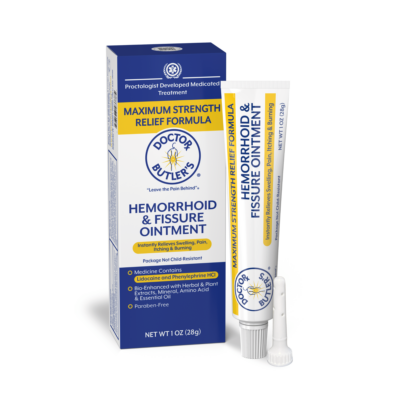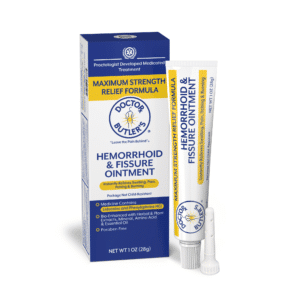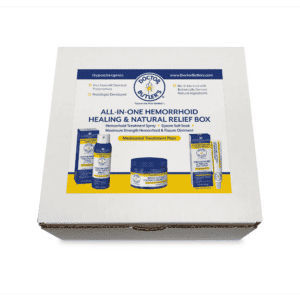Many people are prone to hemorrhoids, but weightlifters and those repeating heavy lifts in general are particularly susceptible. How can you get a hemorrhoid? Pressure on your rectum has a lot to do with it. While we may think of straining in this region as limited to bathroom use, working out often means placing excess pressure on the anus. But lifting weights doesn’t have to result in hemorrhoids, and in fact, daily exercise is an important part of hemorrhoid prevention. Minimize your risk of flare ups by using proper techniques and breath work and staying aware of how your body moves during work outs.
Who are we? We’re Doctor Butler’s, experts in down-there care of hemorrhoids and related conditions. We make proctologist-developed hemorrhoid ointments and complementary products to help you quickly leave the pain behind. Dr. Robert Cutler medically reviews all of the information here.
Hemorrhoids themselves are a cushion of veins that line the anus, helping to store food waste until it’s ready to be released from the body. But hemorrhoids becomes a condition when those veins flare up, a condition so common that the name ‘hemorrhoids’ has come to stand for its resulting symptoms, such as itchiness, burning, bleeding and redness that can impact daily life if not properly treated.
Want to make sure your work out routine isn’t causing hemorrhoids? Find out more below.
Table of Contents
What Are the Signs of Hemorrhoids?
Lifting Weights and Hemorrhoids: Is There a Connection?
How to Prevent Hemorrhoids When Weightlifting
Can You Exercise With Hemorrhoids?
How to Treat Hemorrhoids
When to See a Doctor
Don’t Let Hemorrhoids Weigh You Down!
What Are the Signs of Hemorrhoids?
Hemorrhoids are often mistaken for other disorders, so it’s important to know how to correctly identify them. There are two types of hemorrhoids – internal and external. Internal hemorrhoids are typically painless and often identified by small droplets of blood on toilet paper or in the toilet bowl. They become cause for concern if they prolapse, or push outside the anal canal, forming small red bumps that tend to be itchy and burn. External hemorrhoids form along the outside of the anal lining and appear more blue or purplish in color. They are often mucus-covered and cause a dull ache from stretching the skin.
Lifting Weights and Hemorrhoids: Is There a Connection?
Picking up a dumbbell does not mean a hemorrhoid will suddenly burst forth, so how do you develop hemorrhoids from lifting? The real culprit is actually your breath, which plays a huge role in helping (or hurting) you as you lift weights. To help us complete a heavy lift, we often hold our breath in an attempt to eke out a last surge of energy and force the weight upward. Holding our breath may feel stabilizing, but it forces pressure downward from your diaphragm and into your abdomen. This intra-abdominal pressure (IAP) can then lead to injury in your pelvic floor, nerves or surrounding tissue1, swelling the hemorrhoid veins with blood and decreasing the ability to flow back out2.
How to Prevent Hemorrhoids When Weightlifting
Remember, it isn’t the lifting itself that is causing hemorrhoids, and it is possible to avoid their formation when weight training; technique is everything. Making sure you are utilizing the correct spinal posture not only takes the pressure off your rectum, but it will enhance the effectiveness of your lifting. Maintain a neutral spine, keep your shoulders back and down, slightly contract your abdominals inward and don’t lock your knees. By activating your core you create a stable base from which you can effectively lift weight without risking damage to other parts of your body.
Once you have your posture nailed down, it’s important to focus on breathing. Think of your breath at the throughline that connects all of the moving parts as you lift. Inhale and focus on pushing the air up towards your throat as you lift the weight upward. Breathing in from your abdomen rather than your shoulders takes pressure off of your rectum (the same strain you feel when constipated) and decreases the risk of hemorrhoids. Exhale as you bring the weight back down, continuing this cycle of breathing throughout your entire session.
There is plenty that can be done to prevent hemorrhoids in the gym on top of breath and body work.
- Consider forgoing that weightlifting belt, as it increases intra-abdominal pressure (IAP)3.
- Add pelvic floor exercises to your warm-up. Your pelvic floor forms the bottom of a stabilized core, and is the last line of defense in preventing IAP from reaching the hemorrhoid zone.
- Take breaks as needed to allow your body additional time to recover. Eliminate the risk of transferring pressure elsewhere (including your rectum) if your muscles are overworked.
- Stay hydrated while you work out. You are losing fluids to sweat and heavy breathing, and dehydration is a main culprit behind hemorrhoids. Be mindful of sports or energy drinks that are loaded with sugar and empty calories.
- Eat a balanced diet and avoid pre-packaged workout snacks. While it’s tempting to skip a meal and grab a protein bar or hit that vending machine in the lobby, packaged foods are often loaded with processed ingredients. These are low in fiber and increase the risk of constipation.
Can You Exercise With Hemorrhoids?
Hemorrhoids can feel like a real catch 22 at times. Sitting makes them worse, but moving around risks exacerbating symptoms – how’s a girl or guy supposed to get by! The reality is, exercise is important for hemorrhoids. Cardiovascular exercise in particular helps increase blood flow4, which is a key factor in preventing their formation. Even if lifting isn’t your thing, plenty of exercise options exist beyond the weight room.
Walking, dancing, tennis, basketball, softball – the list of options is truly endless. Anything that feels comfortable for you is doable with hemorrhoids, as long as it doesn’t exacerbate symptoms. If you’re dealing with a flare-up, swimming or water aerobics may provide a more painless outlet. Yoga and pilates can both be low-impact and help stimulate muscle groups that aid in digestion. Cycling or using the stationary bike may end up increasing the pressure on your rectum and should be done with caution.
As with all physical activity, listening to your body and learning which movements cause you to strain the most is essential. Eliminate these exercises from your routine until your hemorrhoids have healed. This may mean a squat or deadlift for some and bench press for others – pay attention to what your rectum is telling you and its particular needs.
How to Treat Hemorrhoids
If you plan to continue lifting with hemorrhoids, it’s important to stay vigilant about treatment methods before, during and after your gym sessions. Your body will subconsciously make adjustments to overcompensate for pain, which can put you at risk for injury or worsening the hemorrhoid.
Over-the-counter ointments and creams can help minimize symptoms and allow you to maintain correct form while you lift. Just as you would ice a pulled or sore muscle, cold compresses and hemorrhoid seat cushions at home will help ensure you are not exacerbating your hemorrhoid as you recover. Get off that toilet! Mindlessly perusing FitTok for an hour while you wait out that bowel movement may be tempting, but it’s wreaking havoc on your hemorrhoid. Sitz baths are simple and effective, helping to restore blood flow before bed and making sure your body gets the rest it needs to heal.
For severe cases, a surgical intervention may be necessary to treat the hemorrhoid. If something feels off down there while you’re hitting the gym, it never hurts to have it checked out by a professional.
When to See a Doctor
Just as you monitor your body for progress as you achieve your weight lifting goals, keeping track of your hemorrhoid symptoms is necessary to ensure recovery. Hemorrhoids that continue bleeding, show increased bleeding, cause unmanageable pain or persist for more than a week without any signs of improvement mean it’s time to seek medical attention. Hemorrhoids that show zero response to at-home treatment attempts also indicate the need to see a doctor. Consulting a physician will ensure that your hemorrhoid is not actually a more serious condition such as colitis that shares overlapping symptoms.
The significance of early and at-home intervention to prevent hemorrhoid complications cannot be stressed enough. With dedicated care and symptom management, hemorrhoids are a treatable condition that do not have to slow you down or worse, keep you out of the gym!
Don’t Let Hemorrhoids Weigh You Down!
Hemorrhoids can be a real drag, but they don’t have to weigh you down any longer. Learning how to prevent and treat hemorrhoids both in and out of the gym helps keep you healthy, happy and active. Doctor Butler’s is here to ensure your routine stays no pain all gain, so make our full line of hemorrhoid support products a part of your personal best today.
Pain ease
No burning . . stays put good solid product for easing pain of private area.
Verified ReviewerMedical Citations
- Gerten, K. A., Richter, H. E., Wheeler, T. L., 2nd, Pair, L. S., Burgio, K. L., Redden, D. T., Varner, R. E., & Hibner, M. (2008). Intraabdominal pressure changes associated with lifting: implications for postoperative activity restrictions. American journal of obstetrics and gynecology, 198(3), 306.e1–306.e3065. https://doi.org/10.1016/j.ajog.2007.09.004 ↩︎
- Fontem RF, Eyvazzadeh D. Internal Hemorrhoid. [Updated 2023 Jul 31]. https://www.ncbi.nlm.nih.gov/books/NBK537182/ ↩︎
- McGill, S. M., Norman, R. W., & Sharratt, M. T. (1990). The effect of an abdominal belt on trunk muscle activity and intra-abdominal pressure during squat lifts. Ergonomics, 33(2), 147–160. https://doi.org/10.1080/00140139008927106 ↩︎
- Shepherd J. T. (1987). Circulatory response to exercise in health. Circulation, 76(6 Pt 2), VI3–VI10. ↩︎




